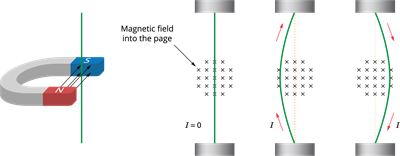
PUMPA - SMART LEARNING
எங்கள் ஆசிரியர்களுடன் 1-ஆன்-1 ஆலோசனை நேரத்தைப் பெறுங்கள். டாப்பர் ஆவதற்கு நாங்கள் பயிற்சி அளிப்போம்
Book Free DemoAccording to H.A.Lorentz, a charge moving in a magnetic field in a direction other than the magnetic field's direction experiences a force. It is called the magnetic Lorentz force. A current is formed by moving charges. A conductor carrying moving charges in a magnetic field that is not in the same direction as the magnetic field will experience a force and cause motion in the conductor.
Consider the following activity to understand better the force acting on a current-carrying conductor.
- Thread a perpendicular wire through a piece of cardboard.
- Make sure the wire is connected in such a way that current flows up it.
- Turn the circuit on.
- Allow the current to run its course.
- Mark the position of a magnetic compass on the cardboard.
- Now move the magnet to a new location and mark it.
- If you join all the points, you will find that it is a circle.
- Reverse the direction of the current; you will find the magnetic circles are clockwise.

Deflection of current-carrying wire in a magnetic field
From this activity, we can deduce that a current-carrying wire has a magnetic field perpendicular to the wire (by looking at the deflection of the compass needle in the vicinity of a current-carrying conductor). The compass needle is deflected, indicating that the current-carrying conductor is exerting a force on it.
In \(1821\), Michael Faradaydiscovered that when a current-carrying conductor is placed in a magnetic field, it is also deflected. The permanent magnet's magnetic field interacts with the magnetic field produced by the current-carrying conductor, resulting in a force on the conductor.